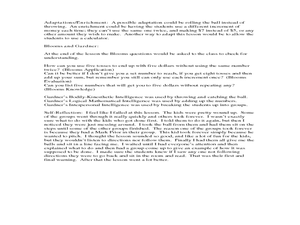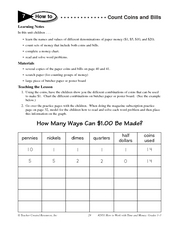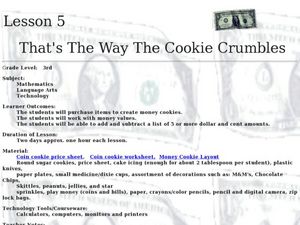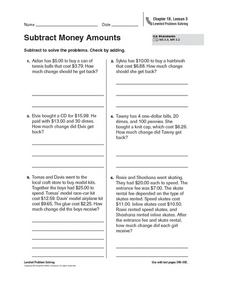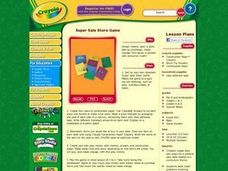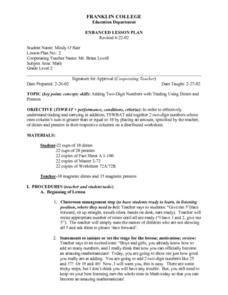Curated OER
Working with Coins #2
Practice money math with a helpful worksheet. Illustrations of coins, along with word problems, keep second graders focused on adding and subtracting different amounts of money. An excellent homework assignment to reinforce your money...
Youthlinc
Financial Literacy: Money Attitudes Lesson Plan
Going once, going twice, sold! An auction provides class members with an opportunity to examine their attitudes toward money. After bidding on and purchasing items, individuals complete an attitude survey and then identify a...
Curated OER
Mental Math for Adding Decimals
Fifth graders work in groups to practice adding decimals. In this adding decimals lesson plan, 5th graders call out different money amounts to each other and mentally add the coins called out. Students take turns calling out and adding...
Curated OER
Counting Money and Making Change
Students count collections of coins and one-dollar bills. They solve problems and learn to use the dollar sign ($) with the decimal point to represent money amounts. This lesson is important as a foundation for future math concepts in...
Curated OER
How To: Count Coins and Bills
Students discover the names and values of different monetary denominations. In this money lesson, students examine the different combinations that money can be added in to find specified amounts. The students complete worksheets based on...
Curated OER
That's The Way the Cookie Crumbles
Third graders work with money values and making purchases. In this money lesson, 3rd graders listen to Donna Guthrie's book, Real World Math: Money and Other Numbers In Your Life. They make money cookies either with a recipe or with...
Curated OER
Hands On: Add and Subtract Money Amounts
In this consumer math worksheet, students use a table and play money to solve each of 8 money story problems. Students will use a price list provided.
Curated OER
Piggin' out with Money
Third graders manage money. In this money math lesson, 3rd graders read Pigs Will be Pigs. Students then use manipulatives to practice adding monetary amounts and making change. Students also practice working with money on selected...
Curated OER
Subtract Money Amounts
In this subtracting money amounts instructional activity, students subtract the money amounts within the word problems. Students solve six word problems.
Curated OER
Expressing Money
Students listen to a book read to them by their teacher and express the amount of money stated with their manipulative of play money and show different ways to express that amount of money.
Curated OER
Act it Out
In this money instructional activity, students solve 5 word problems where they are given an amount of money in written form and make a list to help organize the information in order to add the coin values. Students make change in 4 of...
Curated OER
Double Your Money
What a creative way to delve into adding large numbers! After listening to a story called The King's Chessboard, learners estimate how much money they would have each day following instructions based on doubling and exponentially...
Illustrative Mathematics
Field Day Scarcity
Introduce young mathematicians to concepts of financial literacy with this open-ended word problem. With seven dollars to spend during field day and given a list of available items and their prices, children must determine how they want...
Curated OER
Money
Students practice counting money. For this counting and comparing money lesson, students review the value of coins and use play money to count out five dollars. Students complete a worksheet to determine what items they could...
Busy Teacher’s Café
"Smart" by Shel Silverstein
Find out just how smart your young mathematicians are with this cross-curricular math and language arts lesson. After first reading Shel Silverstein's poem "Smart", learners draw pictures of coins to model the different exchanges...
Curated OER
Buggin' Out (Identifying and Adding Amounts of Money)
Students explore consumer math by participating in estimate exercises. In this currency lesson, students identify and define each piece of U.S. currency and their value to the monetary system. Students complete several money worksheets...
Curated OER
"Money In My Pocket"
Second graders assess a brief history of money, the use of money, working with money as well as adding and subtracting with money and how to spend money wisely with responsibility. In addition, they discuss how everything belongs to God...
Education World
Pot of Gold Addition
In this adding monetary amounts worksheet, students solve 16 problems that require them to find the sums of the addition problems.
Curated OER
Super Sale Store Game
Students help their teacher set up their classroom in the form of a store. Using construction paper, they make different amounts of paper money and items to buy. To end the lesson, they play the game to practice making change and adding...
Curated OER
Adding and Subtracting Money
Students investigate U.S. currency by pretending to buy food. In this money lesson, students discover the vocabulary and value for each U.S. coin, then add the amounts in dollars and cents of food items they wish to purchase....
Curated OER
Keeping Track of Our Money
Second graders complete activities to learn how to manage money. In this managing money lesson, 2nd graders read the book How the Second Grade Got $8,205.50 to Visit the Statue of Liberty and complete two related worksheets.
Curriculum Corner
Menu Math
Getting a meal, side dish, drink, and dessert can be delicious—but it can be expensive too! Practice addition and subtraction with money in a lesson that focuses on a sample menu, complete with task cards and word problems.
Curated OER
Adding Two Digit Numbers with Using Dimes and Pennies
Second graders participate in a math game using dimes and pennies. They practice combining coins to make a given amount of money, and they use the combinations to practice adding two digit numbers. Teacher assessment strategies and...
Curated OER
Money Banks
In this different coins worksheet, 1st graders guess which piggy bank has the most money in it. Then students count the actual amount of money in each piggy bank by counting and adding up the coins.




